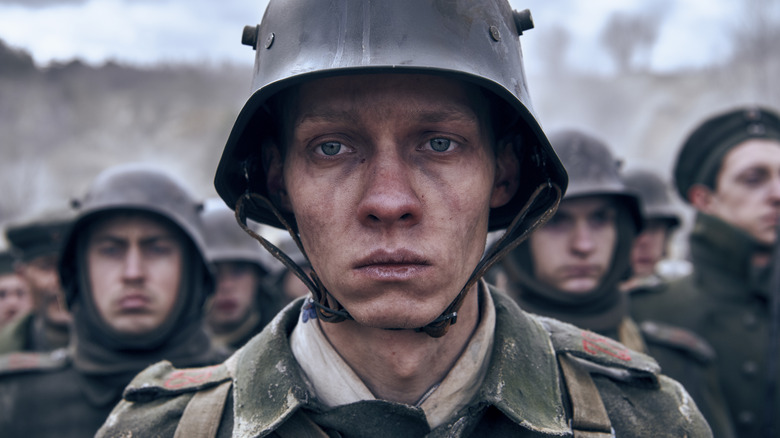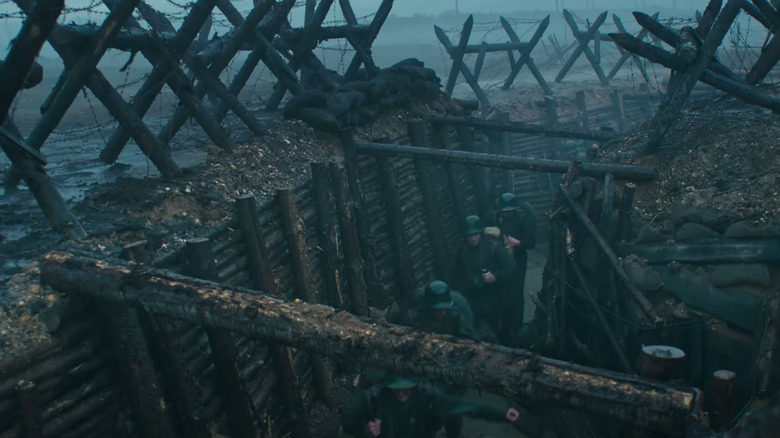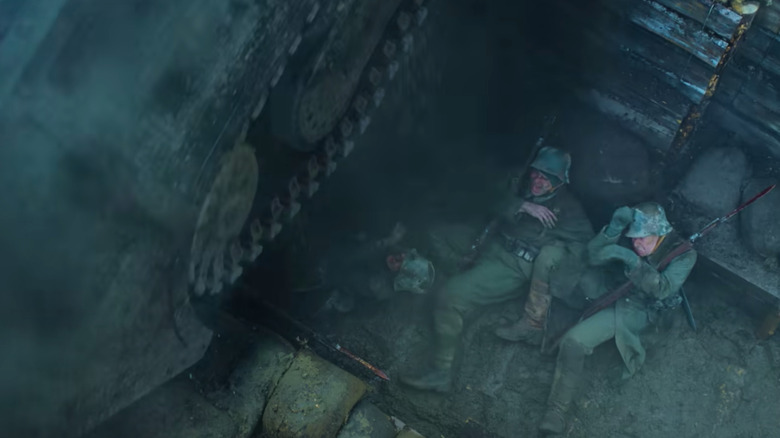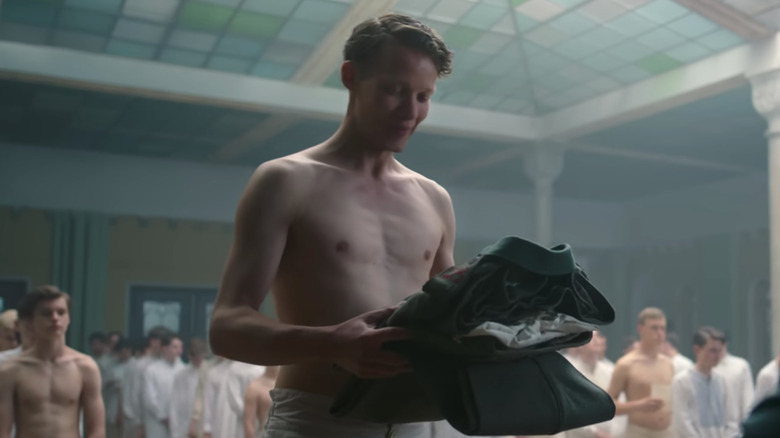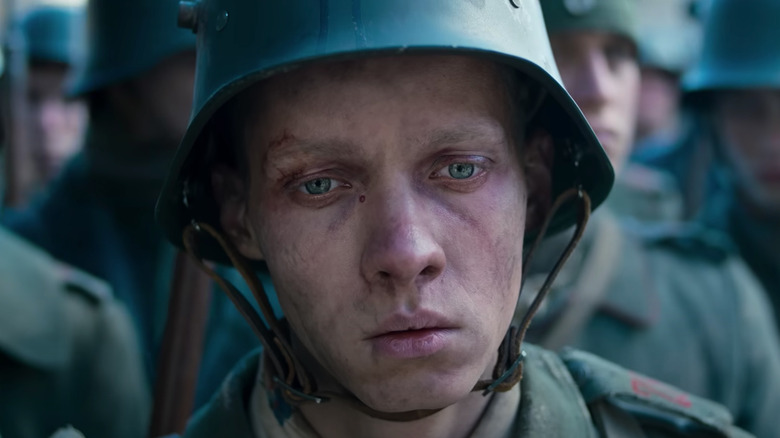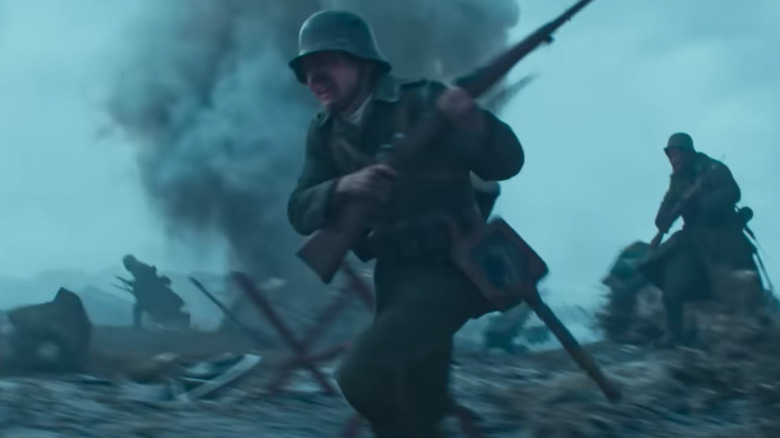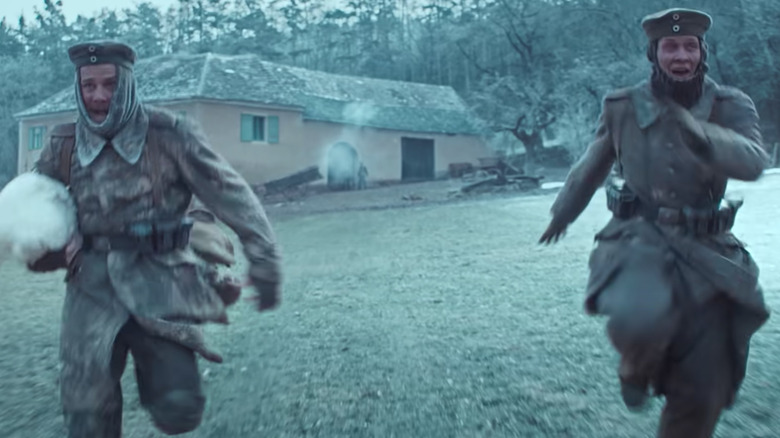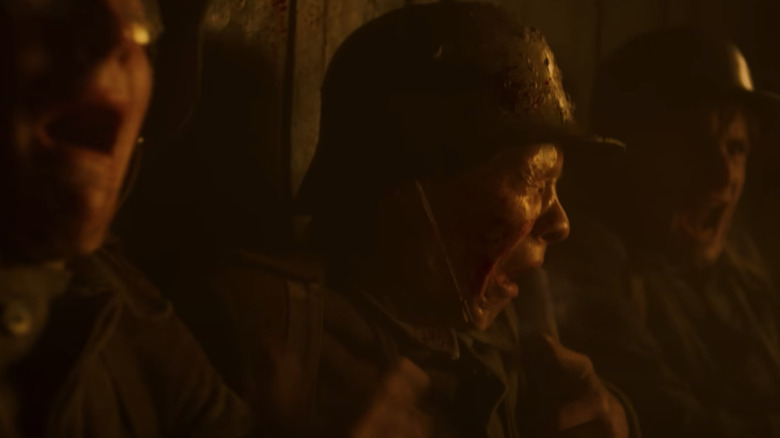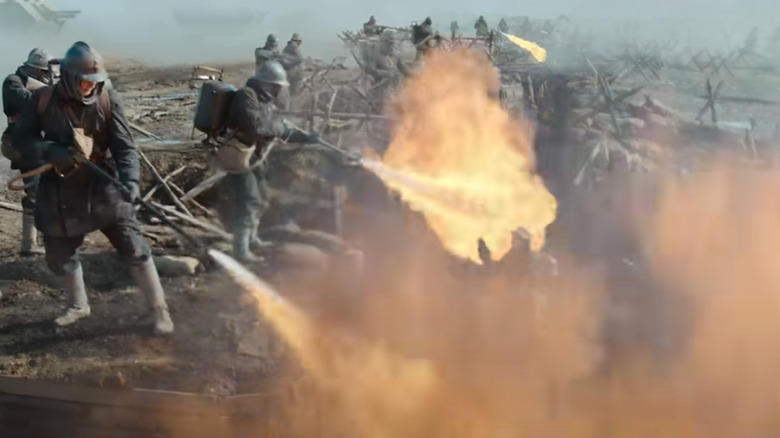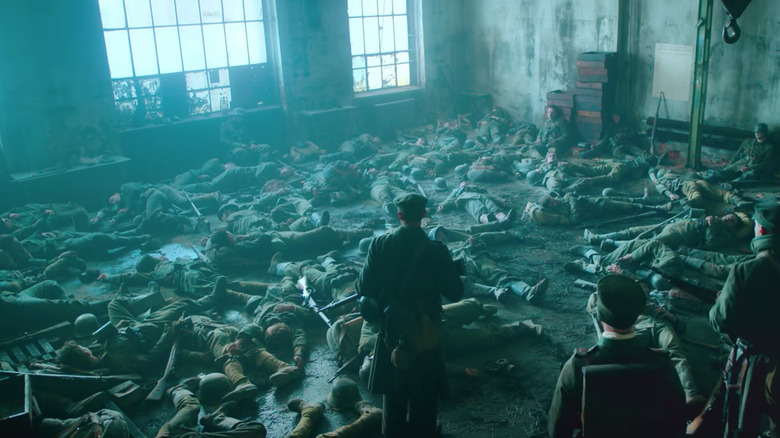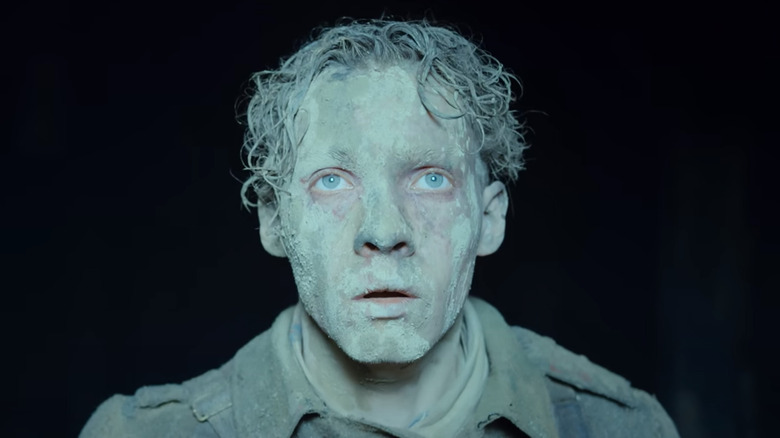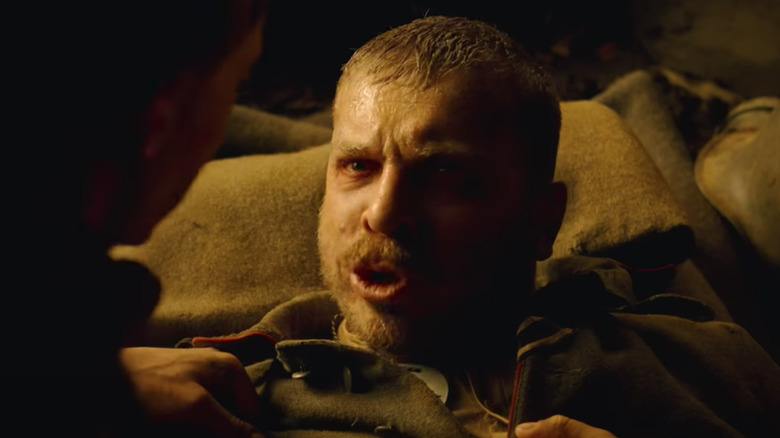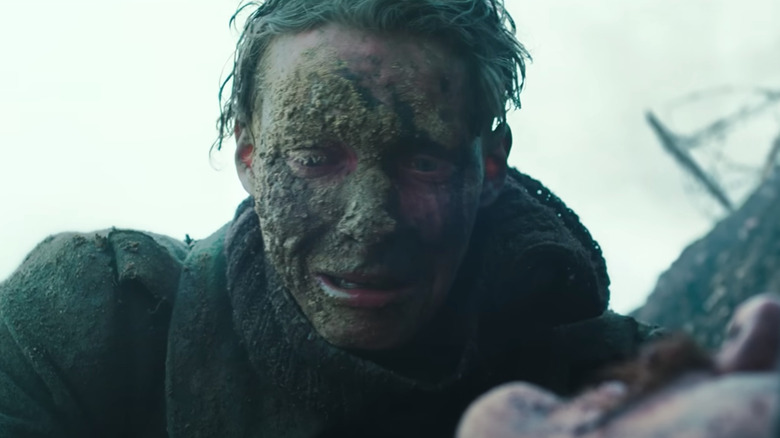All Quiet On The Western Front's 12 Most Intense Moments Ranked
"All Quiet on the Western Front" is a World War I drama that tracks the harrowing experiences of a young German soldier named Paul Bäumer (Felix Kammerer) throughout the final year of the war. The story was adapted from the classic German novel of the same name written by Erich Maria Remarque and first published in 1928, 10 years after the war had ended.
The book had earlier been adapted twice before, once for television in the '70s, but most famously in the 1930 Lewis Milestone film. The first big screen adaptation won the Best Picture and Best Director Oscars and is often considered one of the greatest war films ever made. Now, nearly a century after the book was first written and 93 years after its first adaptation, director Edward Berger's new spin on the material is again a major Academy Awards contender. The film has racked up an impressive nine Oscar nominations, including nods in both the best international film and the best picture categories.
As is the case with many of the best war films, "All Quiet on the Western Front" is really an anti-war film. To drive home this sentiment effectively, the film showcases plenty of brutal and devastating events and images. It is not a film for the faint of heart, but all of its brutality is in service of a powerful message. These are the 12 most intense moments of the film, ranked.
12. The tree
This simple but grotesque sight arrives as our main squad of soldiers is making their way through a forest. Up above them is a corpse stuck in a tree. The implication is that this man was a paratrooper who suffered an unlucky landing. Though the soldier is already dead by the time the main characters discover and comment on him, it remains one of the film's goriest images.
The corpse is mangled nearly beyond recognition and missing large portions of its body. The squad members first spot blood and a tattered uniform before looking up to find the body. One squad member remarks that his body was so thoroughly obliterated that the uniform slid right off what remains of him. This character and this gory visual have no bearing on the plot whatsoever, but it does contribute to the sense of danger and oppressive atmosphere of the setting. It also offers an insight into just how desensitized these soldiers have become by this point in the war, if such a grotesque spectacle hardly makes them bat an eye.
11. The tanks
Both the battle sequences and the sobering end titles make it clear how little progress was made by either side during the war. The German and French armies lose soldiers by the thousands, but neither ever gains more than a few feet of ground against the other. The trench warfare tactics were all about maintaining their positions, and attempts to push forward were often futile. The dangerous territory between the two armies' lines of defense was known as No Man's Land (per the International Encyclopedia of the First World War), and crossing it often spelled certain death.
The battle sequence in which the most ground is gained arrives when the French begin using tanks. The standard firearms of the German soldiers are essentially useless against the tanks' armor, and they find themselves in a helpless situation. The squad of main characters is left hiding in the trench as the French tanks advance and decimate their fellow soldiers.
Hiding in the trenches proves to be far from safe, as one tank careens vertically into the trench and crushes a soldier to death. Other soldiers are nearly rolled over while more are obliterated by the tanks' weapons. The most extreme moment of an already intense sequence arrives when one tank rolls across the opening of the trench, directly over the head of one of the main squad mates. He is mere inches from meeting the same fate as the soldier who was flattened to a pulp just moments earlier.
10. The tags
One less explicitly violent but arguably still harrowing element of "All Quiet on the Western Front" is the way both clothing tags and dog tags are used as a symbol. The clothing tags show up at the beginning of the film. A group of school friends have been convinced through manipulative propaganda to enlist in the military. When they are given their uniforms, Paul notices that his jacket has the wrong name on the tag. The administrator lies about it being a common mistake and tears the tag out, before the camera reveals that the floor beneath the table is littered with similar tags. The German military is re-using the uniforms of dead soldiers. Before even reaching the front, this simple image conveys how these young men are considered more disposable by the war machine than the clothes they wear.
The dog tags factor into the plot a little while later. One of the duties that Paul — and later another soldier — is tasked with is to go around to all the dead bodies, break their dog tags and collect them to record their deaths. The process of gathering all of these dog tags makes it impossible to ignore the sheer volume of death in the trenches, and the image strikes a different chord later on. When the film cuts away from the frontline, countless dog tags are shown littering the desk of a dispassionate higher-up who shows little regard for the amount of life lost.
9. The final attack
After the armistice was signed between France and Germany, the war was brought to a close, but it didn't end immediately. As depicted in the film and confirmed by the U.K. government's official history blog, the actual signing occurred at 5:10 AM, but for ceremonial reasons and to allow word to travel, the ceasefire didn't go into effect until 11 a.m. on the 11th day of the 11th month. This meant that the end of the conflict was in sight, but ongoing warfare for the next few hours would be considered acceptable without violating the terms of the ceasefire agreement.
When the frontline soldiers learn of the armistice, they are relieved and think that they are home free. However, instead of being brought home, they addressed by General Friedrichs. He doesn't value their lives and instead orders them to make one last attack in the final 15 minutes of the war, to catch the French off guard and conclude with a German victory. He sends hundreds of men back into battle and causes countless more casualties for nothing but the sake of his ego. It is estimated that an additional 11,000 soldiers died between the time the armistice was signed and the time that the fighting actually stopped.
8. The intro
"All Quiet on the Western Front" begins right on the frontline of the war. This intro follows a different soldier than the rest of the film, a scared young man named Heinrich, played by Jakob Schmidt. The battlefield is already littered with corpses, and Heinrich watches many more of his allies die all around him from an enemy force that is largely unseen. As he is forced to keep pressing forward, he quickly runs out of ammunition.
The opening scene offers an unfettered glimpse of the desperate measures of warfare right off the bat. This is shown most directly when Heinrich's only course of action is to use the sharp edge of his trench shovel to cleave an enemy soldier, which the film uses as a point of punctuation to cut to the title in silence. The presentation of this sequence using long takes makes it all the more intense. There are only three shots in this roughly two-and-a-half-minute-long sequence, and they are connected together via explosions. After this harrowing opening, the film then cuts to the home front and introduces the main characters. They are eager to enlist and naive about the realities of war, but the audience has already been shown the truth.
7. The child
Once word of the signing of the armistice has spread to the troops, there is overwhelming relief and celebration. Paul and Kat (Albrecht Schuch) head away from the battlefield, thinking themselves home free. When the two pass by the same farmhouse that they had raided for food much earlier in the film, they decide to rob the barn again. Their first raid resulted in them getting shot at, but they made it away unscathed and got their best meal in a long time as a result. Their return-trip robbery again sees them getting caught but this time, they aren't so lucky.
After being robbed twice, the young son of the farmer decides he isn't going to let them get away again. He follows them with his father's rifle and confronts Kat while he is alone in the woods. The film cuts away without showing exactly what happened with the child, but Kat staggers out of the forest to rejoin Paul with a bullet in his torso. They attempt to keep moving, but it isn't long before Kat can no longer walk. Paul resolves to carry him and travels for miles on foot, getting overlooked by a military transport truck that could have aided them.
When Paul finally reaches the hospital, the doctor reveals that Kat was shot in the liver and died at some point along the journey. Paul is left in disbelief, convinced that all their hardships had to be worth something.
6. The glasses
The four young school friends are, at first, excited to enlist in the army and head to the battlefield. It doesn't take long for the idealized, heroic vision of warfare they had been fed to crumble under the brutal truth of war. Their period of training is virtually non-existent as they are shipped off straight to the frontline. On their very first night in the trenches, the reality of their situation sinks in. Ludwig (Adrian Grünewald) panics and begs to go home. Paul tries to calm him but is panicking himself, and their situation only grows worse as their bunker is hit directly by an artillery barrage. Total chaos follows into the morning.
Once the dust settles, Paul tries to regroup with his friends. He is heartbroken to find Ludwig's glasses on the ground, broken. He frantically searches the corpses scattered throughout the trench until eventually finding him dead. Within 24 hours of enlisting, Paul has already lost his first close friend. He will lose many more before the war is over.
5. The flamethrowers
Any time viewers think they have gotten used to the presentation of the battle scenes in "All Quiet on the Western Front," the film switches things up. One way the film keeps the action consistently surprising and harrowing is by introducing flamethrowers used by the French army. This leads to one of the film's most intense moments and to the death of one of the main squad mates.
As the French gain ground and push back the German line of defense, it becomes clear to what's left of the German troops that their only option is to retreat. Albert (Aaron Hilmer) is caught too close to the advancing troops to stand a chance of fleeing. He tries to surrender instead, but the advancing army isn't interested in showing mercy. They burn him alive with a flamethrower as Paul watches from the distance. As if that wasn't intense enough already, Albert lives for an excruciatingly long time. He attempts to crawl to a nearby puddle of muddy water to put out the fire and nearly makes it before being finished off.
4. The gas
Partway through the war, a massive battalion of reinforcements go missing. They aren't responding to communication attempts and they seem to have all vanished without a trace. Assigned to track them down is the main squad, whose unit is meant to be bolstered by these new recruits. Paul and the others head to their last known location, which is a train yard.
After arriving, they note how the area seems too quiet and appears to be completely abandoned. When they look inside a nearby building, the horrifying truth is discovered. The entire regiment of new recruits lays dead, 60 in total, turning the building into a mass grave. Paul's squad determines that they were killed by gas and that they removed their masks too early. They were killed before they knew what was happening to them. The characters note that the population of Germany is dwindling and that the country cannot sustain such exorbitant casualties. According to the International Encyclopedia of the First World War, over two million German soldiers died throughout the course of the war with over seven million total casualties — a little more than half the total number of Germans involved in the war.
3. The bayonet
On the final day of the war, Germany's General Friedrichs sends hundreds of soldiers back into battle in the hopes of ending the conflict with one last German victory. It is a pointless continuation of the bloodshed; the soldiers on the frontline are well aware of this fact, but are forced to fight on anyway.
By this point in the war, Paul has watched all of his friends die around him. He is hardened by warfare and desensitized to the violence. In the final 15 minutes before the ceasefire goes into effect, he storms into an enemy trench and puts all of his battle experience to use. After killing a few French soldiers, he finds himself locked in close-quarters combat with one enemy soldier in particular. The two tumble down into a bunker, away from the chaos in the trenches. For a brief instant, it seems like the two might be able to quell their conflict and quietly wait out the closing moments of the war, but a third man intervenes.
A previously unseen French soldier hiding in the bunker rams a bayonet through Paul from behind, piercing his heart. Within seconds, the ceasefire goes into effect, and the war ends permanently. This intense moment, arriving so close to the ceasefire, perfectly hammers home just how pointless Paul's death and the countless other deaths like his are.
2. The fork
After the main squad is separated for a time due to their forced retreat, they — or at least what's left of them — finally reunite away from the battlefield in a city center. Only three of them remain alive, and Tjaden (Edin Hasanovic) has been severely wounded in the retreat. Paul and Kat find Tjaden laid up in the infirmary with a badly mangled leg that will likely need to be amputated.
There is a brief period of celebration in which the trio are happy to be reunited. They have warm food for the first time in a while, and there are rumors that peace is being negotiated and the war will be over soon. Things are looking up for once, but not for Tjaden. His dreams of civilian life and a career in law enforcement back home are dashed by his injury, and he can't take the suffering anymore. When Paul and Kat bring him food, Tjaden jams the fork into his throat. He stabs himself several times before Paul and Kat manage to stop him, and by then, it is too late to stop the bleeding. Their happy reunion immediately becomes one of the film's most intense and most somber moments.
1. The crater
When the German troops are forced to retreat, the main squad scatters in different directions. Paul doubles back for Albert, who lags behind. Before he can reach him, Albert is roasted alive by French flamethrowers. Now panicked and alone, Paul scrambles for safety in the hellish no man's land. He winds up taking shelter inside a massive crater in the middle of the battlefield. Meanwhile, a French soldier tumbles down into the opposite side of the crater. Without his gun, Paul scrambles through the mud to attack the solder with his knife. He stabs the man multiple times, but he stays alive even as Paul rolls off him, exhausted.
Paul is unable to leave the crater without being instantly killed in the battle, so he's forced to remain with the dying soldier. What follows is an excruciatingly drawn-out sequence where Paul reckons with his actions. The sounds made by the wounded soldier get to Paul, and he tries to shut him up by shoving mud into his mouth. Moments later, Paul regrets his actions. He gives the French soldier water and provides first aid. He even lies to the dying man and tells him he is an ally in French, erasing the divide between them. His last-minute change of course is all for naught when the soldier finally dies. Paul has been taught to dehumanize the enemy to make them easier to kill, but that's impossible to do when seeing this man's final moments up close and personal.
